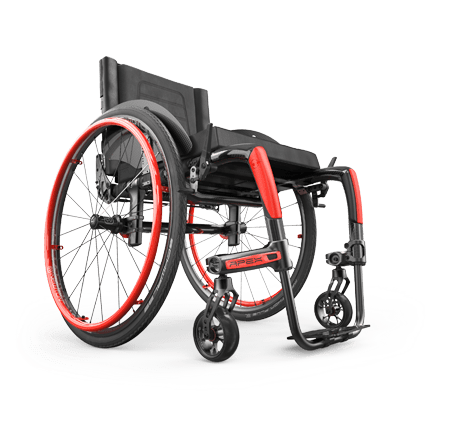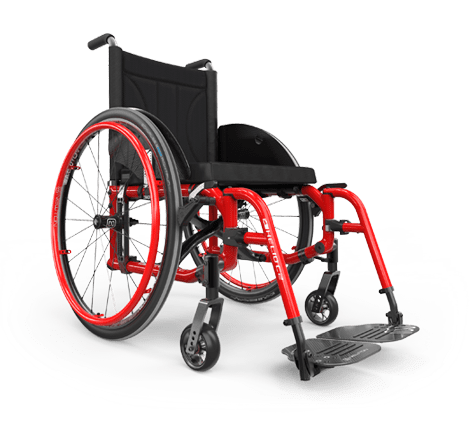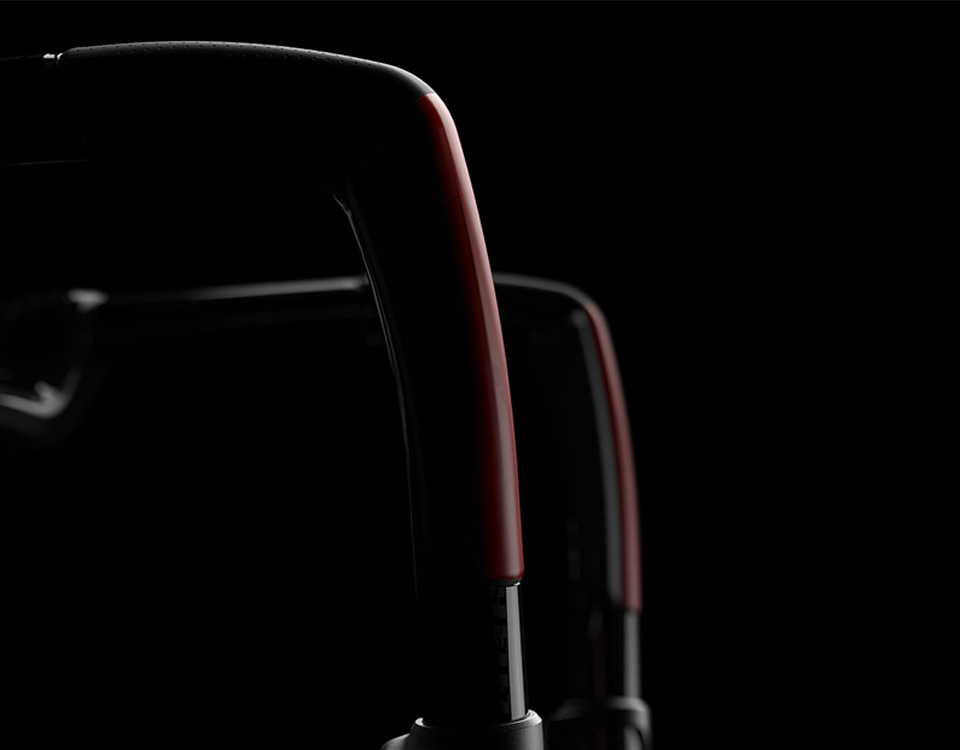The front frame angle is measured from the horizontal pane of the floor to the front frame of the rigid wheelchair. This measurement from the horizontal, and not the rest of the wheelchair frame, is unique to rigid wheelchairs within the industry. This angle choice will have an impact on the lower extremity position and wheelchair footprint which will lead to further impact on the environmental access as well as overall maneuverability. Here we will review in detail how the front frame angle of a rigid wheelchair can impact the overall function of the end user.
Impact on Function:
Lower Extremity Positioning
Although the front frame angle is not the equivalent to the knee angle, it does have an impact on lower extremity positioning. Upon ordering, the angle is measured to the floor which allows for an initial configuration that is independent from all other aspects of the wheelchair configuration. Once the initial wheelchair is dispensed, changing other angles such as rear seat to floor height can impact the front frame angle and can, therefore, alter how lower extremities are positioned. Although post-evaluation changes tend to be minor, it is something to consider.
If the front rigging places the knee in a position outside of what the hamstring will allow, the user can be forced to accommodate for this and typically we will see less desirable postures such as sacral sitting. If the front rigging places the knee at a position outside of what the quadriceps will allow, it will cause limited knee flexion which can lead to an anterior rotation of the pelvis, trunk hyperextension and imbalance.
Either of the above-mentioned scenarios can impact the ability to access the footplate. Loss of loading through the feet will cause an increase in pressure at the ischial and coccyx predisposing one for pressure injuries. It is important to point out that although the front-end angle will impact and is impacted by the knee angle, if possible, most end-users will self-select where they put their feet on a footplate and many footplate options allow adjustability to customize height, depth and angle as needed.
Footprint
The amount of space a chair takes up is dependent on many different elements of the configuration: front frame angle, seat to floor height, frame length and seat depth are on top of the list of what truly affects a wheelchair footprint. These configurations, especially in conjunction with each other, will affect user accessibility and stability.
Accessibility
When considering the front frame angle, you will need to consider environment and lifestyle. Will tight spaces need to be navigated daily? what are the outdoor demands? Will there be frequent transfers to a small automobile? Since the front frame angle directly impacts the position of the front end of the wheelchair, some configurations will take up more space than others and this should be considered for each individual user and access to environments
Stability
Stability is partially created by the front frame angle and caster location. The more forward the casters are, the larger the base of support. For example, with an 80-degree front angle, the caster will be more forward from the rear wheel than with an 85-degree front end angle. Therefore, the lower quantity angle will be less “tippy” forward. It would therefore be safer to pick things up off the floor and would be easier during floor recovery than at a higher quantity angle.
Configuration Impact Example:
Most aspects of manual wheelchairs are impacted by other factors of configuration and should be looked at simultaneously. Wheelchair footprint is directly affected by the front-end angle especially when considering different front seat to floor heights. Here is a sample of a comparison of how front seat to floor height can impact wheelchair footprint when looking at different front-end angles.
16” Front Seat to Floor Height
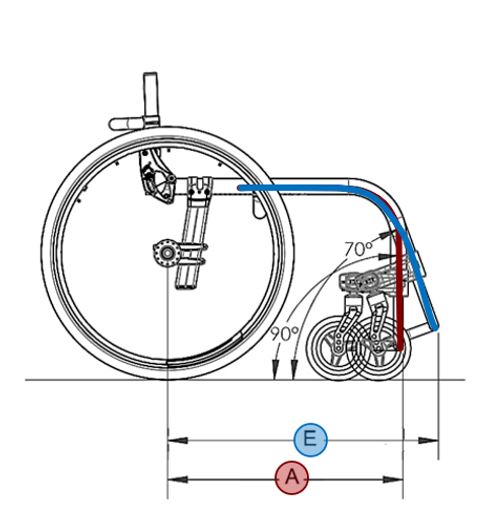
| IDENTIFICATION LETTER |
FRONT FRAME ANGLE (deg) |
REFERRAL ADDED DIMENSION (mm) |
REFERRAL ADDED DIMENSION (in) |
| A |
90 |
0 |
0 |
| B |
85 |
+18.6 mm |
+0.73'' |
| C |
80 |
+36.4 mm |
+1.43'' |
| D |
75 |
+54.1 mm |
+2.13'' |
| E |
70 |
+71.5 mm |
+2.81'' |
Note: Those dimensions are only for reference, based on a 16'' deep and 16'' front seat to floor wheelchair.
Vs.
19” Front Seat to Floor Height
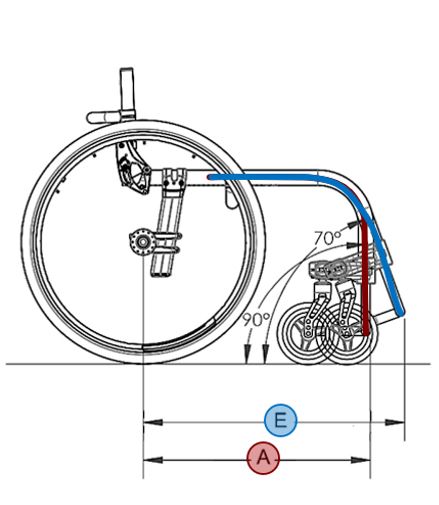
| IDENTIFICATION LETTER |
FRONT FRAME ANGLE (deg) |
REFERRAL ADDED DIMENSION (mm) |
REFERRAL ADDED DIMENSION (in) |
| A |
90 |
0 |
0 |
| B |
85 |
+25.4 mm |
+1.00'' |
| C |
80 |
+50.2 mm |
+1.98'' |
| D |
75 |
+74.8 mm |
+2.94'' |
| E |
70 |
+99.7 mm |
+3.93'' |
Note: Those dimensions are only for reference, based on a 16'' deep and 16'' front seat to floor wheelchair.
In an industry where every inch counts, you can see the impact the front frame angle has on each respective wheelchair’s footprint.
Evaluation Process:
Now that we understand the importance of the front frame angle and its impact on the overall wheelchair, here is a simple guide to follow during the wheelchair evaluation step of the process to ensure the front frame angle is being addressed:
- Lower extremity range of motion – You will need to understand the limitations of the end user’s knee flexion and extension movements. Also consider ankle plantarflexion contractures.
- Transfer abilities - Can they transfer out of the chair without their lower extremities getting caught in footplates or footrests? Depending on the client, this is where you can consider the angle degree of the footrest as well as style (i.e., standard, flip up, or flip back).
- Tolerance of dependent lower extremities- Considerations of pain level and/or edema should also be considered. This can be communicated directly from the end user’s past experiences.
- Environment – Home, community, public facilities, and place of employment are important to know when making this decision. Consider a smaller front frame angle or pair with freewheel for added stability where needed. In a big city, curb cuts can be an obstacle with smaller front frame angles as well.
As you can see, the front frame angle is a very important aspect of a rigid manual wheelchair and can be difficult to determine due to the influence of the many factors outlined above. Ultimately, the ideal front frame angle is achieved when you have optimal pelvis positioning, even pressure distribution throughout thighs, feet stabilized on the foot plate and proper environmental accessibility. Completing a well-rounded evaluation using the provided guidelines and listening to the user’s needs is how we achieve optimal outcomes for manual wheelchair configuration, including the front-end angle.





